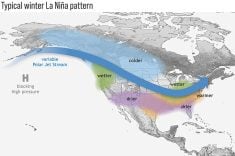PORTAGE LA PRAIRIE, Man. – An American sunflower breeder is putting the finishing touches on research for a sunflower tolerant to the imazethapyr family of herbicides
Jerry Miller from the United States Department of Agriculture in Fargo, N.D., said he will do his final residue trials next summer for the sunflowers.
They will be marketed under the Clearfield system, similar to the Smart system for canola.
Miller told growers at a recent meeting of the National Sunflower Association of Canada that the herbicide-tolerant sunflower is not a genetically modified variety.
Read Also

Canadian Food Inspection Agency extends chronic wasting disease control program consultation deadline
Date extended for consultation period of changes to CWD program
The tolerant genes come from a wild sunflower found growing in a field planted to soybeans seven years in a row. It was tolerant to the pesticide.
Miller crossed the sunflower with NuSun varieties using traditional breeding techniques.
He thinks the system may be commercially available for U.S. growers in 2002.
Researchers develop tolerant sunflower developed
Saskatchewan Agriculture
News release
Entomosporium leaf and berry spot has been the most prominent and persistent disease of commercial saskatoons in Saskatchewan.
Although losses of marketable fruit vary from year to year, they can be as high as 100 percent.
However, two commercial fungicides were recently made available and saved many crops from destruction.
These fungicides, Kumulus and Topas, were developed by Piara Bains, a research scientist with Alberta Agriculture, whose project was funded by Saskatchewan Agriculture.
The economic losses due to ELBS result from the spotting, cracking and deformation of the fruit.
The prevention of these problems should not be through chemical means alone.
Bains’s project focused on the role of leaf litter as a primary source of inoculum. The project also monitored the progress of the disease in commercial saskatoon orchards and determined the susceptibility of saskatoon cultivars and the effect of temperature on the growth and germination of ELBS spores.
“We found that removal of litter such as leaves and fruits in early spring from under the bushes did not inhibit the development of the disease. Infected fruit and pedicles that remain attached to the bushes may provide inoculum for initiation of the disease, but this has not been confirmed.”
Bains also discovered different saskatoon cultivars had different responses to infection by the ELBS inoculum, although none were resistant. The cultivar Success was the least susceptible.
“Although there are no bio-controls or resistant cultivars available as yet, integrated disease management of ELBS can be partially implemented. For example, saskatoon bushes should be planted in open areas where the wind can remove the moisture necessary for the disease to thrive.
“Meanwhile, we will continue to fine-tune the chemical control of the disease – determine the best time to spray the fungicide – and, in conjunction with researchers at the University of Saskatchewan, work towards the identification and development of a ELBS-resistant cultivar,” said Bains.
Clarence Peters, fruit development specialist with Saskatchewan Agriculture, said the results of Bains’s project have been valuable to saskatoon growers.
“The two new fungicide registrations offer more flexibility in disease control, and the new information about disease transmission will be a relief to growers who were wasting time cleaning up leaf litter,” he said.
Peters has prepared a three-page information sheet called Management Practices to Control Entomosporium Leaf and Berry Spot in Saskatoon Berry Crops, which includes guidelines for the strategic use of fungicides.
It is available at Saskatchewan Rural Service Centres.














